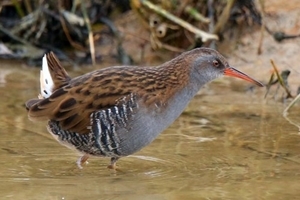Water rail
 Having spent more time than usual indoors during a very soggy autumn, I was beginning to wonder what countryside inhabitant I would write about this November. Until this weekend, when I was listening to a hilarious account by a friend trying to convince me she had heard a distressed pig in a reedbed near her house. Aha, I thought, I bet it’s a water rail! And if it isn’t, well, you’ll have a fun afternoon with the pig farmer and the fire brigade.
Having spent more time than usual indoors during a very soggy autumn, I was beginning to wonder what countryside inhabitant I would write about this November. Until this weekend, when I was listening to a hilarious account by a friend trying to convince me she had heard a distressed pig in a reedbed near her house. Aha, I thought, I bet it’s a water rail! And if it isn’t, well, you’ll have a fun afternoon with the pig farmer and the fire brigade.
The water rail is one of our most elusive wetland birds, preferring well-vegetated edges of rivers, ponds and marshes. In Britain it is most often recorded from southern coastal regions and eastern fens, but it actually has a wide resident and breeding distribution here and in other parts of Europe.
Some populations on the continent are migratory, and UK numbers are boosted in winter by birds flying in by cover of darkness from Scandinavia. The water rail is one of many bird species that prefer to migrate nocturnally – as long as you know where you’re going, it has several advantages including: a) less likely to get attacked by a predator, b) the air is usually less turbulent, and c) the air is cooler, allowing birds to dump huge amounts of heat generated by long-distance flight!
Their closest relatives amongst the British waterbirds are the coot and the moorhen. The water rail is smaller and slimmer, roughly the size of a redshank, and has a slate-grey underbody, with streaky brown plumage on its back and black and white barring under its tail. Combined with a red bill and pale pink legs, you’d think this colourful appearance makes it stand out, but it is perfectly camouflaged in amongst the stems and reflections in the water’s edge. The male is usually more boldly marked than the female, and he uses his courtship performance to show off his flanks.
Water rails have a diverse omnivorous diet, which is a good survival strategy in this day and age! They will eat plant matter such as roots, seeds and berries as well as insects and larvae, worms, fish, molluscs, small amphibians and even small birds – one source claims to have observed a water rail impale a wren! All this food can be found amongst vegetation and scrub standing in soft river mud and shallow water. Reedbeds made up of common reed or reed-canary grass are ideal habitats, especially with a bit of willow carr or woodland edge thrown into the mix.
A pair of water rails will make a large, cup-shaped nest 5-10cm above the surface of the wetland in thick vegetation. They have a good strategy for breeding – large clutches and an extended breeding season from March to June – which allows for double broods and compensates for chick losses in a frequently changing environment prone to flooding and drought.
Their vocabulary is just as colourful as their plumage: whistling in flight, purring to their broods and metallic trilling in courtship – with their famous pig-like squealing and grunting reserved for alarm calls, announcements and territorial warnings.
Water rails are thought to be quite common and, in fact, are almost certainly under-recorded by normal breeding bird survey methods. They respond quite well to call-playbacks, as they can be quite territorial and feisty. So, to maximise your chances of encountering this lovely secretive waterbird, you could go down to the nearest reedbed with a piglet tucked under your arm and give it a poke – or just get a birdsong app!
Jess Brooks
Advisory
Photo credit: Martin Blackmore